
views
X
Research source
If you are crafting a headdress, learn about the culture you are imitating. Be aware that dressing as a Native American for a parties or Halloween festivities is likely to upset those aware of the long history of violence against the indigenous peoples of the United States.
Crafting a Feather Headband
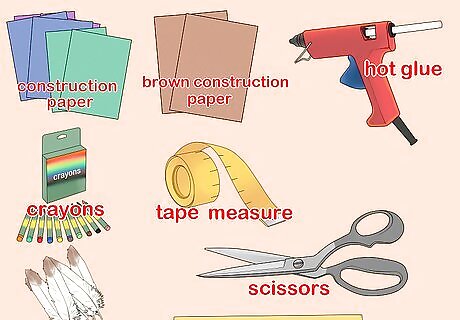
Get your supplies together. You will need scissors, a tape measure, a ruler, brown construction paper, crayons or paint, craft or hot glue, and either feathers (as many as you like) or more colors of construction paper. If you are making paper feathers, you will be able to get up to one feather for every inch your construction paper is wide. However, you may wish to buy several colors of construction paper, and cut one or two feathers from each.
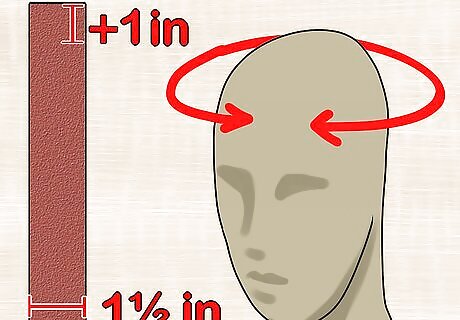
Cut a strip of brown construction paper. The strip should be about 1½ inches (3.8 cm) in width. It should also be long enough to wrap around the wearer's head with a little extra overlap space. Add roughly 1 inch (2.5 cm) extra to the length. This overlap length will allow you to glue the ends together securely in order to form a band later on. Feather headbands were worn by a few tribes of the northeast Woodland, such as the Lenape and Abenaki. They were worn by men and women alike, and were not associated with battle. Pick a sturdy brown paper so it looks like leather. Pick another color if you would rather have a different color band. Actual feathered headbands were typically woven or beaded, so feel free to use an alternative color for your band. Alternatively, beaded turbans became popular among Cherokee, Seminoles and other southeastern indigenous men when cloth became easily available in the 1800s, so consider wrapping a turban and tucking a feather into it. You can print and use this template instead. Indian Headdress Template
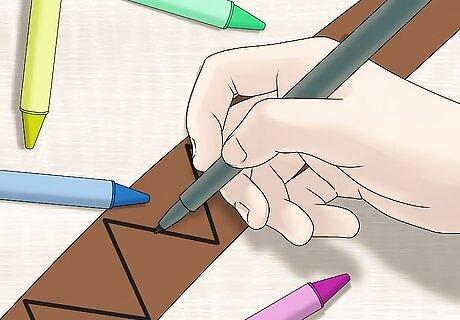
Decorate the band. Use markers, crayons, paint, or colored pencils to create a colorful design, perhaps inspired by a tribe such as the Wampanoag, Lenape, and Abenaki. You can find patterns online, or in books about Woodland Indian tribal patterns. Purple and white beads were favored by tribespeople in the Northeast, such as the Wampanoag. Draw a geometrical pattern along the band. For instance, draw a series of triangles within triangles of alternating colors. Draw the lines along a ruler to make them straight. If you want your band to appear beaded, you can paint dabs of color. If making an art project with a child, give your child a ruler and a limited color palette (2-4 crayons, for instance) and explain that the pattern should be the same all around.
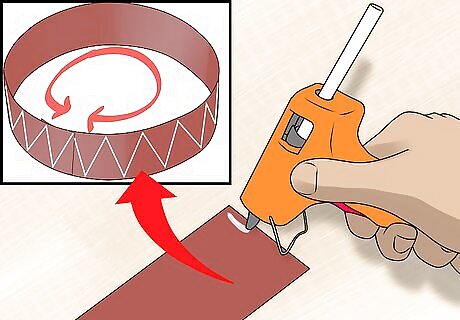
Glue the ends together. Apply a dot of craft glue on one end of the band, on the decorated side. Wrap the strip into a band and press the end of the other side on top of the glue. Let dry. There should be about 1 inch (2.5 cm) of overlapping paper. If craft glue will not hold the paper headband together, use a glue stick or a stronger type of glue, such as hot glue. If you are using real or craft feathers, you can glue them on at this time. Put a few dots of glue on the inside of the band, and arrange one or more feathers so that they stand up. If you have multiple feathers, arrange them so they fan out slightly from one another.
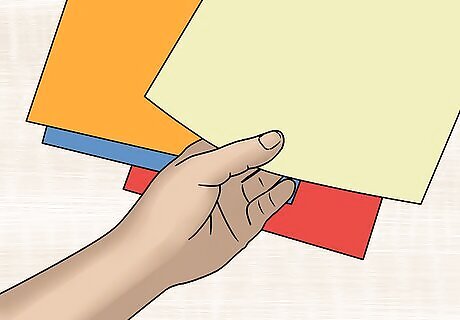
Pick paper for feathers. If you do not have real feathers or craft feathers, you can make your own by cutting fringes into colorful ovals of construction paper. Any color and number of feathers will do. You might choose red, yellow, and orange, or use colors that you used when decorating the brown band.
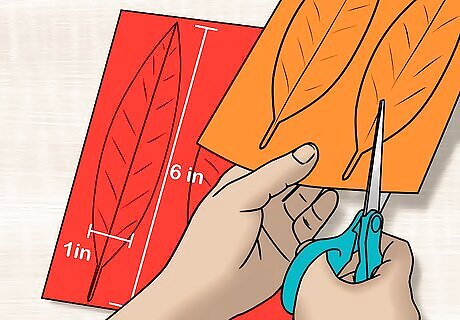
Cut out each feather. Draw a narrow oval on your first piece of construction paper. The oval should be at least 6 inches (15 cm) long by 1 inch (2.5 cm) wide. Cut the oval out.
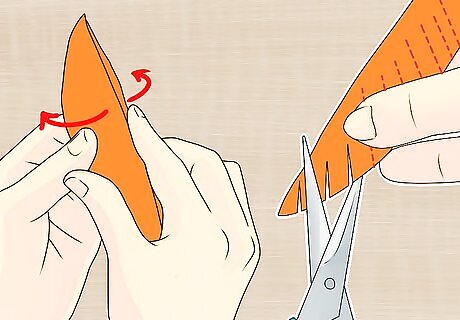
Fold and slit the feathers. Fold the oval in half lengthwise. Cut slits along the open, curved edge. Make sure that the slits do not cross each other or cut through the straight, folded edge. The slits should extend from top to bottom. Folding the feathers creates the feather's shaft. Don't worry about the fold being perfectly centered, as feathers are not always symmetrical. Unfold the paper feather. Repeat with other colors of construction paper.
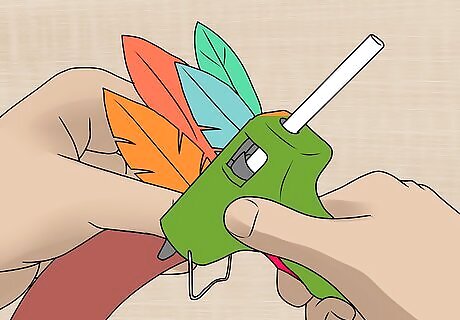
Glue your feathers to the band. Glue your paper or craft feathers to the inside of your headband and let dry. The feathers should all extend up and out from the band at a single point. One feather can stand straight up, but the other two should fan out slightly.
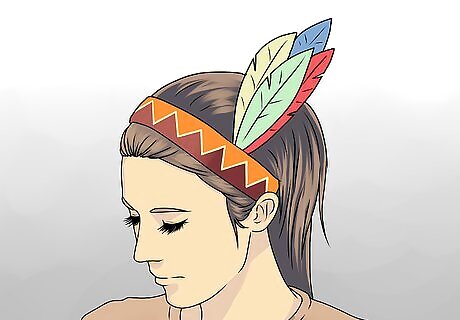
Wear the headband at home. When wearing the headband, position it so that the feathers are behind the wearer's ear on one side of his or her head. Incorporate this costume choice with a lesson on the tribe whose designs you are borrowing. Most native people consider "indigenous costumes" offensive. Please avoid dressing as any racial stereotype for Halloween. Understand that you will seriously offend the people whose culture you are borrowing from if you paint your skin, or sexualize minority groups whose oppression includes a long history of sexual violence. If you must dress as someone from another race, dress as a specific person. Take the time to research and dress as the historical Pocahontas, not the Disney character.
Paper and Feather Warbonnet
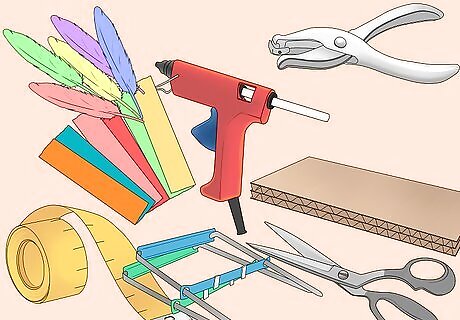
Gather supplies. You will need scissors, a tape measure, a hole puncher, a 2-prong paper fastener, and craft glue or hot glue. You will also need corrugated fiberboard, crepe paper, and craft feathers or paper to make paper feathers.
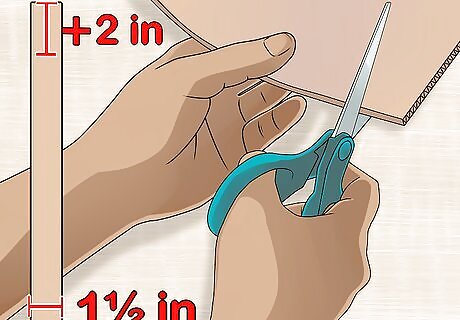
Cut a strip of corrugated fiberboard. The strip should be 1 1/2 inches (3.8 cm) wide and 2 inches (5 cm) longer than the length required to fit around the intended wearer's head. Corrugated fiberboard, also called corrugated cardboard or corrugated paper, has narrow ridges or holes along the inside, making it a little lighter than standard cardboard but also a little thicker. Choose a thin piece of corrugated fiberboard to make it easier to wrap it around into a band-like form. These instructions will allow you to create a "straight-up" style warbonnet, in which the feathers extend vertically from the headband.
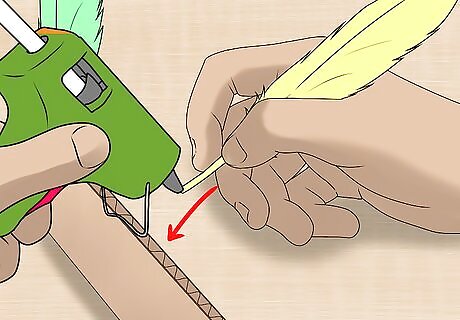
Stick feathers into the holes of the cardboard. Apply a small dot of glue to the top of each corrugated hole, inside the hole itself. Attach the stem of a craft feather to each dot of glue and let dry. To make it easier for the feathers to stick to the glue, you may want to keep the cardboard flat, attaching the feathers horizontally rather than vertically. Use craft glue or hot glue to hold the feathers in place.

Overlap the ends of the headband. Fold the headband over so that the extra 2 inches (5 cm) of length overlap. Use a hole puncher to punch a hole in each end and slip a 2-pronged paper fastener through these holes. Spread the prongs out to hold the band in place. For extra security, punch two holes in each end, one near the top and one near the bottom, and use two 2-pronged fasteners to hold the band together.
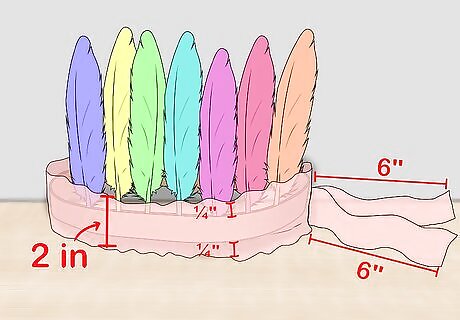
Cover the outside. You may use cloth, beads, or bright red crepe paper. The paper strip should be 2 inches (5 cm) wide and 1 foot (30.5 cm) longer than the length of the band. Center and paste the crepe paper strip over the band of fiberboard. There should be about 1/4-inch (0.635 cm) hanging off the top and bottom of the band and 6 inches (15 cm) hanging down from both ends.

Frill the edges of the crepe paper. If using crepe paper to cover, frill the edges. Use scissors to cut 1/4-inch (0.635-cm) fringes along the top and bottom of the crepe paper. This completes your headdress. When wearing the headdress, the feathers should stand upright over the head.
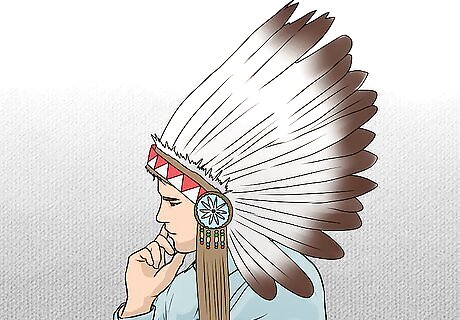
Design an alternative warbonnet. There isn't one single style of warbonnet, so look through pictures of trailer warbonnets, halo warbonnets, and straight-up warbonnets for design ideas. About a dozen tribes, all in the Great Plains region, wore bonnets to reward bravery and great deeds. Tribes that used warbonnets include the Sioux, Crow, Blackfeet, Cheyenne, and Plains Cree. A warbonnet is a sacred symbol that honors great deeds. They are not worn by most tribe members. Modern-day Native Americans might earn a warbonnet for advocacy or scholarship. You are likely to offend people if you wear a warbonnet as a costume.
Weaving a Headband
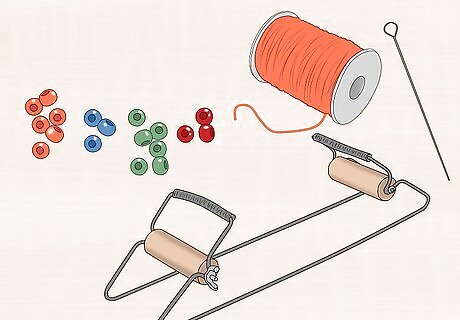
Obtain supplies. You will need beads, beading string, and a beading needle. You will also need a beading loom. If you have a beading loom and beading kit, go for larger seed beads and one large toggle bead to finish. If you are starting from scratch, buy a small bag of beads in the colors you want to use. The beads should all be the same size, though you may buy one larger one to seal the headband if you want. Build a loom. You can make a beading loom by attaching two combs to a sturdy box or box lid. Take two matching combs, or snap a single comb in half. Tape or glue each comb to parallel sides of the box, each at the edge, so that the teeth protrude into the air. Buy string for beading. A slightly elastic string will make your headband more comfortable.

Design your headband. Beaded headbands were worn by members of many tribes, including those of the Cheyenne, Sioux, Crow, Sauk, Fox, Winnebago, Kickapoo, Cree, and Arapaho. Search online for patterns traditional to these tribes, or find one in a book about North American beadwork. You can also invent your own design. Draw your design on graph paper, coloring in the squares to represent the beads you will use. You run less risk of offending a native person if you opt for a beaded headband, as they hold less spiritual significance than feathered warbonnets or headdresses.
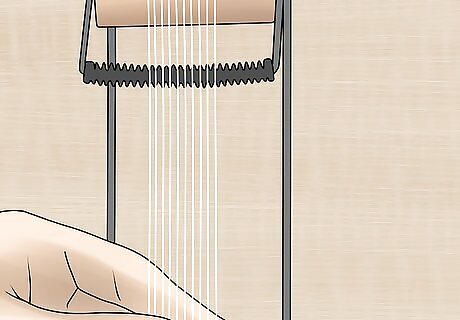
Thread your loom. Tie beading string to the leftmost tooth of the loom (or comb), then stretch taut across the loom and cut it to size, leaving two or three inches of string hanging loose outside the loom. Tie the loose end to the leftmost tooth of the other side of the loom. Repeat until you have enough parallel strings to contain your design.
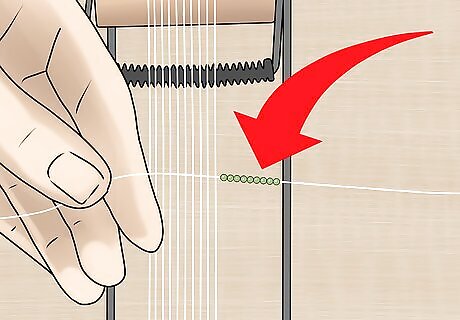
Thread the beads on a long string. Arrange your pattern to match your loom, in a vertical line, and start counting beads from the top row. Count out the first 5 lines of your pattern and thread the corresponding beads onto a long thread in the order you have counted. Count from left to right for the first row, then right to left for the second, then left to right, etc. This is because you will be weaving the beaded string through the strings on the loom from left to right, then right to left, switching each time a row ends.
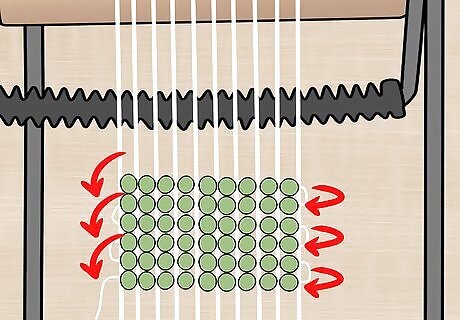
Weave your headband. Tie the end of the string to a needle, and weave in and out of the rows. Go over the first string, under the next, then over, then under. Weave your first row at the loom's top, weaving left to right. You'll end up on the right: start the same process again from the right, then back again from the left. Stop after your first five rows to see if the pattern is coming out as you'd planned. If it is, line up your next 5 rows on the string and keep weaving. If it isn't, undo your glitchy rows and count your beads again.
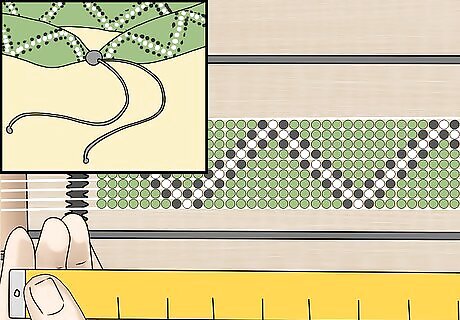
Tie it off. Use a tape measure to measure the head of the person who will wear the headband. Weave until you have reached that length, or an inch shorter if you want to tie off the ends. Cut your headband free, and tie the two or three inches of thread you left hanging together so that the beads stay in place. You may tie a large bead to one side, and make a loop with the other, large enough to go around the bead. Trim for tidiness. If you don't want to use the large bead method, you can tie the dangling thread on each side in a knot. Tie the two knotted ends together when you want to wear your band. If your band fits exactly, you can tie the ends together tightly and wear it as is.
















Comments
0 comment